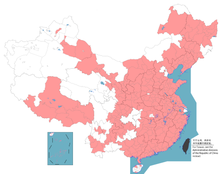Prefecture-level City
| Prefecture-level municipality Prefecture-level city Prefectural-level city |
|||||||||||||||
 |
|||||||||||||||
| Simplified Chinese | 地级市 | ||||||||||||||
|---|---|---|---|---|---|---|---|---|---|---|---|---|---|---|---|
| Traditional Chinese | 地級市 | ||||||||||||||
| Literal meaning | Regional-level municipality | ||||||||||||||
|
|||||||||||||||
| Transcriptions | |
|---|---|
| Standard Mandarin | |
| Hanyu Pinyin | Dìjíshì |
| Hakka | |
| Romanization | thi-kip-sṳ |
| Yue: Cantonese | |
| Jyutping | dei6 kap1 si5 |
A prefectural-level municipality (Chinese: 地级市), prefectural-level city or prefectural city is an administrative division of the People's Republic of China (PRC), ranking below a province and above a county in China's administrative structure. Prefectural level cities form the second level of the administrative structure (alongside prefectures, leagues and autonomous prefectures). Administrative chiefs (mayors) of prefectural level cities generally have the same rank as a division chief (Chinese: 司长) of a national ministry. Since the 1980s, most former prefectures have been renamed into prefectural level cities.
A prefectural level city is a "city" (Chinese: 市; pinyin: shì) and "prefecture" (Chinese: 地区; pinyin: dìqū) that have been merged into one unified jurisdiction. As such it is simultaneously a city, which is a municipal entry with subordinate districts, and a prefecture with subordinate county-level cities and counties which is an administrative division of a province.
A prefectural level city is often not a "city" in the usual sense of the term (i.e., a large continuous urban settlement), but instead an administrative unit comprising, typically, a main central urban area (a city in the usual sense, usually with the same name as the prefectural level city), and its much larger surrounding rural area containing many smaller cities, towns and villages. The larger prefectural level cities span over 100 kilometres (62 mi).
...
Wikipedia
